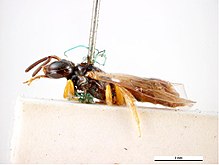| Exoneura | |
|---|---|

| |
| Exoneura richardsoni | |
| Scientific classification | |
| Domain: | Eukaryota |
| Kingdom: | Animalia |
| Phylum: | Arthropoda |
| Class: | Insecta |
| Order: | Hymenoptera |
| Family: | Apidae |
| Tribe: | Allodapini |
| Genus: | Exoneura Smith, 1854 |
Exoneura (also called the Reed bee) is a genus of social bees belonging to the taxonomic family Apidae. This genus has glossy black head and thorax with a black or red-orange abdomen. The species of this genus are found only in Australia, often in small burrows they dig up themselves. Members of this genus are generally 8 millimeters (mm) in length. This species is parasitized by members of the genus Inquilina. This relationship with Inquilina has been going on for approximately 15 million years.
Burrows
This species are often found in small burrows which two or more adult Exoneura can be found in. They put pollen and nectar inside their burrows which they lay their eggs on. Their nest can contain many young at several stages of life.
Behavior
Behavioral plasticity
The Exoneura genus exhibits notable behavioral plasticity observed in many of its species including E. robusta and E. bicolor. Environmental factors experienced by this species that impact its behavior include nesting substrate, predation and parasitization, and resource availability. Focused substrate preferences have been show to create localized nest aggregations which impact behaviors such as task specializations. Task specialization in one species of Exoneura, E. bicolor, expresses as altruistic behaviors seen as guarding and nest absenters who face an increased individual risk for the health and success of the colony.
Species
| This section needs expansion. You can help by adding to it. (May 2021) |
Species:
- Exoneura abstrusa Cockerell, 1922
- Exoneura albolineata Cockerell, 1929
- Exoneura albopilosa Rayment, 1951
- Exoneura richardsoni
- Exoneura robusta
- Exoneura bicolor
References
- ^ "Exoneura Smith, 1854". www.gbif.org. Retrieved 10 May 2021.
- "Reed Bees (Exoneura)". www.aussiebee.com.au. Retrieved 2023-11-10.
- Shokri Bousjein, Nahid; Tierney, Simon M.; Gardner, Michael G.; Schwarz, Michael P. (February 2022). "Does effective population size affect rates of molecular evolution: Mitochondrial data for host/parasite species pairs in bees suggests not". Ecology and Evolution. 12 (2): e8562. Bibcode:2022EcoEv..12E8562S. doi:10.1002/ece3.8562. ISSN 2045-7758. PMC 8820120. PMID 35154650.
- "Exoneura species, f, australia, side | U.S. Geological Survey". www.usgs.gov. Retrieved 2023-11-10.
- ^ Silberbauer, L. X.; Schwarz, M. P. (June 1995). "Life cycle and social behavior in a heathland population of the allodapine bee,Exoneura bicolor (Hymenoptera: Apidae)". Insectes Sociaux. 42 (2): 201–218. doi:10.1007/BF01242455. ISSN 0020-1812.
- ^ Schwarz, Michael P. (December 1987). "Intra-colony relatedness and sociality in the allodapine bee Exoneura bicolor". Behavioral Ecology and Sociobiology. 21 (6): 387–392. Bibcode:1987BEcoS..21..387S. doi:10.1007/BF00299933. ISSN 0340-5443.
- Melna, P. A.; Schwarz, M. P. (March 1994). "Behavioural specialization in pre-reproductive colonies of the allodapine beeExoneura bicolor (Hymenoptera: Anthophoridae)". Insectes Sociaux. 41 (1): 1–18. doi:10.1007/BF01240569. ISSN 0020-1812.
| Taxon identifiers | |
|---|---|
| Exoneura | |